Experimental and Numerical Investigation of the Seismic Performance of Bridge Columns with High-Strength Reinforcement and Concrete
Abstract
:1. Introduction
2. Experimental Procedure
2.1. Specimen Design
2.2. Material and Sectional Properties
2.3. Construction and Test Setup
2.4. Instrumentation and Loading Procedure
3. Results and Discussion
3.1. General Observations and Failure Modes
3.1.1. BMRC1, NEWRC 1–5 Columns
3.1.2. NEWRCF Frame
3.2. Hysteresis Loops
3.3. Backbone Curves
3.4. Strength and Displacement Ductility
3.5. Stiffness Degradation
3.6. Energy Dissipation Capacity
3.7. Equivalent Viscous Damping Ratio (ξeq)
3.8. Residual Drift Ratio
3.9. Minimum Transverse Reinforcement
4. Numerical Simulation
4.1. Model Development
4.1.1. OpenSees Simulation Model
4.1.2. Rotational Slip Spring
4.1.3. Buckling Shear Spring
4.2. Numerical Results of NEWRC Columns
4.3. Verification of the Numerical Model Using NEWRCF
5. Conclusions
- The failure process of NEWRC columns was similar to that of the BMRC1 column and consisted of four stages: cracking, yield, ultimate, and failure. Longitudinal rebar buckling was identified as the contributing factor for all the column’s failure, and it was influenced by the spacing of the transverse reinforcement. NEWRC1 had a similar force-displacement relationship as BMRC1 despite a reduced cross-sectional area, longitudinal reinforcement area, and transverse reinforcement area.
- In comparison among the NEWRC specimens, the ductility ratio of NEWRC1, NEWRC4, and NEWRC5 were higher than 5, thus satisfying the MOTC-2020 code requirement. On the other hand, for NEWRC2 and NEWRC3, it was lower than 5. The results suggested that transverse reinforcement’s spacing greatly influenced its ductility ratio and failure pattern, especially in the elastoplastic zone.
- The energy dissipation capacity and equivalent viscous damping ratio of NEWRC columns are compared with BMRC1. Hence, the results suggested that using HSC and HSR can result in lower energy dissipation and equivalent viscous damping ratio compared to conventional RC columns. For NEWRC columns, within a certain range, a higher axial load ratio, such as in NEWRC4, resulted in an increased energy dissipation capacity.
- NEWRC5 had a similar force-displacement, energy dissipation, viscous damping ratio, and residual drift ratio as NEWRC1. Hence, the replacement of HSR transverse reinforcement with NSR did not necessarily influence the column’s seismic performance under a low axial load. Therefore, the combination of NSR for transverse reinforcement and HSR for longitudinal reinforcement in bridge columns can be more economical.
- The ACI 318-19 code equations for minimum transverse reinforcement consider the strength of transverse reinforcement; however, from the comparison between NEWRC1 and NEWRC5, it was observed that it would increase the overall volume of reinforcement which would be unnecessary, especially under the low axial load.
- NEWRCF had a similar failure pattern as NEWRC1, with the leading cause of failure being the buckling of the longitudinal rebar. Overall, NEWRCF had a good seismic response, as a ductility ratio of 5.19 was recorded, and the residual drift ratio was below 1%, even at a higher drift ratio of 3%.
- The numerical model developed in OpenSees using a buckling shear spring was able to predict the seismic performance of the high-strength columns precisely. Moreover, the model also considered the material strength, transverse reinforcement spacing, and axial load ratio and predicted the shear-strength degradation due to longitudinal rebar buckling with high accuracy. The proposed numerical model can further be applied to investigate the seismic performance of a broader range of high-strength columns in both buildings and bridges.
Author Contributions
Funding
Institutional Review Board Statement
Informed Consent Statement
Data Availability Statement
Acknowledgments
Conflicts of Interest
References
- Shahrooz, B.M. Design of Concrete Structures Using High-Strength Steel Reinforcement. In Transportation Research Board; Transportation Research Board: Washington, DC, USA, 2011; Volume 679. [Google Scholar]
- Kelly, D.J.; Lepage, A.; Mar, D.; Restrepo, J.; Sanders, J.C.; Taylor, A.W. Use of high-strength reinforcement for earth-quake-resistant concrete structures. In Proceedings of the NCEE 2014—10th U.S. National Conference on Earthquake Engineering: Frontiers of Earthquake Engineering, Anchorage, AK, USA, 21–25 July 2014; pp. 21–25. [Google Scholar]
- Aoyama, H.; Murota, T.; Hiraishi, H.; Bessho, S. Development of advanced reinforced concrete buildings with high-strength and high-quality materials. In Proceedings of the Tenth World Conference on Earthquake Engineering, Madrid, Spain, 19–24 July 1992; Balkema AA Publishers: Rotterdam, The Netherlands, 1992; pp. 3365–3370. [Google Scholar]
- Barcley, L.; Kowalsky, M. Seismic Performance of Circular Concrete Columns Reinforced with High-Strength Steel. J. Struct. Eng. 2020, 146, 04019198. [Google Scholar] [CrossRef]
- Cusson, D.; Paultre, P. High Strength Concrete Columns Confined by Rectangular Ties. J. Struct. Eng. 1994, 120, 783–804. [Google Scholar] [CrossRef]
- Salim, R.R.; Murat, S. Strength and Deformability of Confined High-Strength Concrete Columns. ACI Struct. J. 1994, 91, 678–687. [Google Scholar] [CrossRef]
- Foster, S.J.; Attard, M.M. Strength and Ductility of Fiber-Reinforced High-Strength Concrete Columns. J. Struct. Eng. 2001, 127, 28–34. [Google Scholar] [CrossRef]
- Yu-Chen, O.; Dimas, P.K. Shear Behavior of Reinforced Concrete Columns with High-Strength Steel and Concrete. ACI Struct. J. 2015, 112, 35–45. [Google Scholar] [CrossRef]
- Muguruma, H.; Watanabe, F. Ductility Improvement of High-Strength Concrete Columns With Lateral Confinement. ACI Symp. Publ. 1990, 121, 47–60. [Google Scholar] [CrossRef]
- Li, B.; Park, R.; Tanaka, H. Stress-Strain Behavior of High-Strength Concrete Confined by Ultra-High- and Normal-Strength Transverse Reinforcements. ACI Struct. J. 2001, 98, 395–406. [Google Scholar] [CrossRef]
- Shi, Q.; Ma, L.; Wang, Q.; Wang, B.; Yang, K. Seismic performance of square concrete columns reinforced with grade 600 MPa longitudinal and transverse reinforcement steel under high axial load. Structures 2021, 32, 1955–1970. [Google Scholar] [CrossRef]
- Zhang, J.; Cai, R.; Li, C.; Liu, X. Seismic behavior of high-strength concrete columns reinforced with high-strength steel bars. Eng. Struct. 2020, 218, 110861. [Google Scholar] [CrossRef]
- Rautenberg, J.M.; Pujol, S.; Tavallali, H.; Lepage, A. Drift Capacity of Concrete Columns Reinforced with High-Strength Steel. ACI Struct. J. 2013, 110, 307–317. [Google Scholar] [CrossRef]
- Barbosa, A.R.; Link, T.; Trejo, D. Seismic Performance of High-Strength Steel RC Bridge Columns. J. Bridge Eng. 2016, 21, 04015044. [Google Scholar] [CrossRef]
- Lucas, A.L.; Santiago, P. Drift Demands on Reinforced Concrete Structures Subjected to Strong Ground Motions. ACI Struct. J. 2019, 116, 103–115. [Google Scholar] [CrossRef]
- Duy, V.T.; Jack, P.M. Special Moment Frames with High-Strength Reinforcement—Part 1: Beams. ACI Struct. J. 2020, 117, 239–253. [Google Scholar] [CrossRef]
- Aishwarya, Y.P.; Santiago, P. Reinforcement Limits for Reinforced Concrete Elements with High-Strength Steel. ACI Struct. J. 2019, 116, 201–213. [Google Scholar] [CrossRef]
- Rautenberg, J.M.; Pujol, S.; Tavallali, H.; Lepage, A. Reconsidering the use of high-strength reinforcement in concrete columns. Eng. Struct. 2012, 37, 135–142. [Google Scholar] [CrossRef]
- ACI. Building Code Requirements for Structural Concrete and Commentary (ACI 318-19); American Concrete Institute: Farmington Hills, MI, USA, 2019; Volume 623. [Google Scholar]
- Perceka, W.; Liao, W.-C.; Wang, Y.-D. High Strength Concrete Columns under Axial Compression Load: Hybrid Confinement Efficiency of High Strength Transverse Reinforcement and Steel Fibers. Materials 2016, 9, 264. [Google Scholar] [CrossRef] [Green Version]
- Ou, Y.-C.; Dimas, P.K. Effect of Axial Compression on Shear Behavior of High-Strength Reinforced Concrete Columns. ACI Struct. J. 2015, 112, 209–220. [Google Scholar] [CrossRef]
- Liao, W.-C.; Perceka, W.; Yu, L.-C. Systematic Mix Procedures for Highly Flowable-Strain Hardening Fiber Reinforced Concrete (HF-SHFRC) by Using Tensile Strain Hardening Responses as Performance Criteria. Sci. Adv. Mater. 2017, 9, 1157–1168. [Google Scholar] [CrossRef]
- Cheng, M.-Y.; Marnie, B.G. Cyclic Behavior of Reinforced Concrete Flexural Members Using High-Strength Flexural Reinforcement. ACI Struct. J. 2014, 111, 893–902. [Google Scholar] [CrossRef]
- Ou, Y.-C.; Nguyen, N.V.B. Stress Limit for Shear Reinforcement of High-Strength Columns. ACI Struct. J. 2022, 119, 131–143. [Google Scholar] [CrossRef]
- NCREE. Design guideline for the building of high-strength reinforced concrete structures (draft) (NCREE-19-001). In Proceedings of the National Center for Research on Earthquake Engineering, Taipei, Taiwan, 15–19 September 2019. [Google Scholar]
- AASTHO. AASHTO LRFD Bridge Design Specifications; American Association of State Highway and Transportation Officials: Washington, DC, USA, 2017. [Google Scholar]
- Su, J.; Dhakal, R.P.; Junjie, W. Fiber-based damage analysis of reinforced concrete bridge piers. Soil Dyn. Earthq. Eng. 2017, 96, 13–34. [Google Scholar] [CrossRef]
- Su, J.; Wang, J.; Li, Z.; Liang, X. Effect of reinforcement grade and concrete strength on seismic performance of reinforced concrete bridge piers. Eng. Struct. 2019, 198, 109512. [Google Scholar] [CrossRef]
- Mazzoni, S.; McKenna, F.; Fenves, G. OpenSees Command Language; Pacific Earthquake Engineering Research (PEER) Center: Berkeley, CA, USA, 2001. [Google Scholar]
- Wu, D.; Ding, Y.; Su, J.; Li, Z.-X.; Zong, L.; Feng, K. Effects of tie detailing configurations on reinforcement buckling and seismic performance of high-strength RC columns. Soil Dyn. Earthq. Eng. 2021, 147, 106791. [Google Scholar] [CrossRef]
- Shen, J.J.; Yen, W.P.; O’Fallon, J. Development of a Handbook for Seismic Performance Testing of Bridge Piers. In Proceedings of the Sixth U.S. Conference and Workshop on Lifeline Earthquake Engineering (TCLEE), Long Beach, CA, USA, 10–13 August 2003; Advancing Mitigation Technologies and Disaster Response for Lifeline Systems. pp. 133–142. [Google Scholar] [CrossRef] [Green Version]
- Crespi, P.; Zucca, M.; Longarini, N.; Giordano, N. Seismic Assessment of Six Typologies of Existing RC Bridges. Infrastructures 2020, 5, 52. [Google Scholar] [CrossRef]
- Crespi, P.; Zucca, M.; Valente, M. On the collapse evaluation of existing RC bridges exposed to corrosion under horizontal loads. Eng. Fail. Anal. 2020, 116, 104727. [Google Scholar] [CrossRef]
- Saetta, A.V.; Vitaliani, R.V. Experimental investigation and numerical modeling of carbonation process in reinforced concrete structures: Part I: Theoretical formulation. Cem. Concr. Res. 2004, 34, 571–579. [Google Scholar] [CrossRef]
- Mohamed, N.; Farghaly, A.S.; Benmokrane, B.; Neale, K.W. Drift Capacity Design of Shear Walls Reinforced with GFRP Bars. ACI Struct. J. 2014, 111, 1397. [Google Scholar] [CrossRef]
- MOTC. Seismic Design Specification of Highway Bridge; Ministry of Transportation and Communication: Taipei, Taiwan, 2020.
- Berry, M.P.; Eberhard, M.O. Practical Performance Model for Bar Buckling. J. Struct. Eng. 2005, 131, 1060–1070. [Google Scholar] [CrossRef]
- Jin, L.; Zhang, S.; Han, J.; Li, D.; Du, X. Effect of cross-section size on flexural compressive failure of RC columns: Monotonic and cyclic tests. Eng. Struct. 2019, 186, 456–470. [Google Scholar] [CrossRef]
- Lignola, G.P.; Prota, A.E.; Manfredi, G.; Cosenza, E. Non-linear modeling of RC rectangular hollow piers confined with CFRP. Compos. Struct. 2009, 88, 56–64. [Google Scholar] [CrossRef]
- Cheng, H.; Li, H.; Wang, D.; Sun, Z.; Li, G.; Jin, J. Research on the influencing factors for residual displacements of RC bridge columns subjected to earthquake loading. Bull. Earthq. Eng. 2016, 14, 2229–2257. [Google Scholar] [CrossRef]
- Chadwell, C.; Imbsen, R. XTRACT: A Tool for Axial Force—Ultimate Curvature Interactions. In Proceedings of the Structures Congress 2004: Building on the Past, Securing the Future, Nashville, TN, USA, 22–26 May 2004; American Society of Civil Engineers: Reston, VA, USA, 2004; pp. 1–9. [Google Scholar]
- Lee, H.-J.; Lai, Y.-L.; Chen, C.-W.; Tao, C.-C. Behavior and modeling of high-strength concrete tied columns under axial compression. J. Chin. Inst. Eng. 2018, 41, 353–365. [Google Scholar] [CrossRef]
- Liu, K.-Y.; Witarto, W.; Chang, K.-C. Composed analytical models for seismic assessment of reinforced concrete bridge columns. Earthq. Eng. Struct. Dyn. 2015, 44, 265–281. [Google Scholar] [CrossRef]
- Kenneth, J.E.; Marc, O.E. Effective Stiffness of Reinforced Concrete Columns. ACI Struct. J. 2009, 106, 476. [Google Scholar] [CrossRef] [Green Version]
- Elwood, K.J. Shake Table Tests and Analytical Studies on the Gravity Load Collapse of Reinforced Concrete Frames. Ph.D.Thesis, University of California, Berkeley, CA, USA, 2002. [Google Scholar]
- Xiao, Y.; Martirossyan, A. Seismic Performance of High-Strength Concrete Columns. J. Struct. Eng. 1998, 124, 241–251. [Google Scholar] [CrossRef]
- Frederic, L.; Patrick, P. Behavior of High-Strength Concrete Columns under Cyclic Flexure and Constant Axial Load. ACI Struct. J. 2000, 97, 591–601. [Google Scholar] [CrossRef]
- John, H.T.; John, W.W. Lateral Load Behavior of Reinforced Concrete Columns Constructed Using High-Strength Materials. ACI Struct. J. 1994, 91, 605–615. [Google Scholar] [CrossRef]
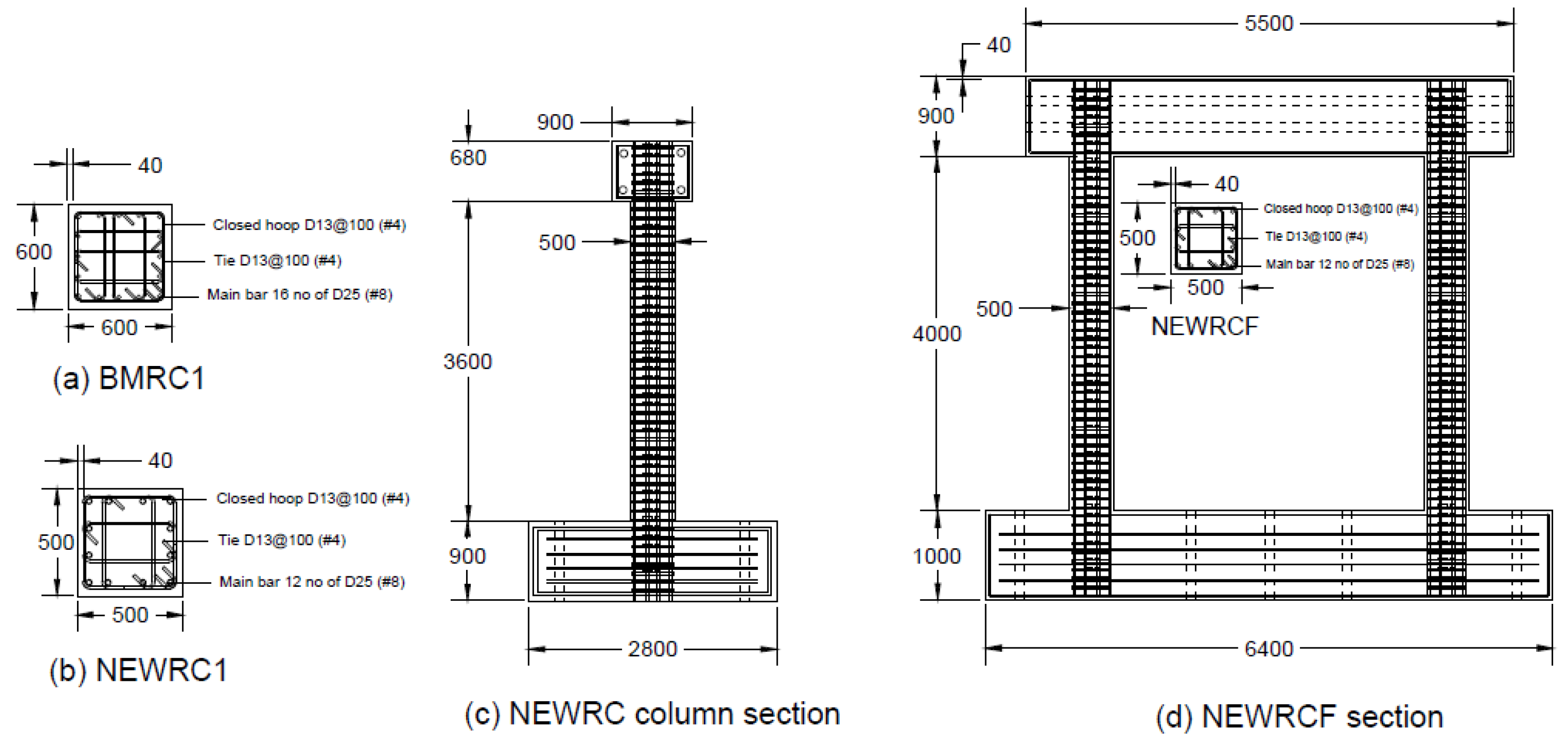
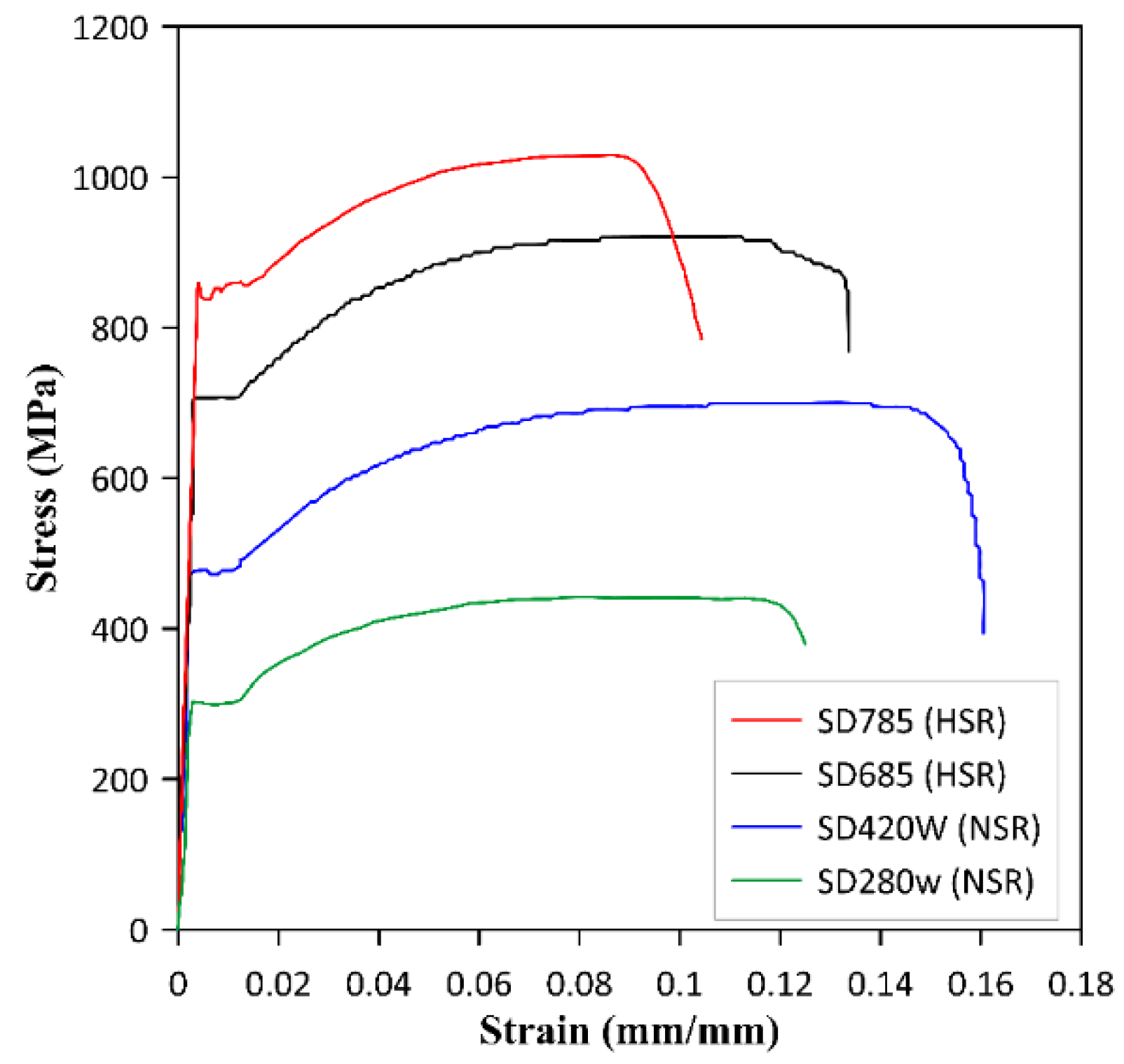
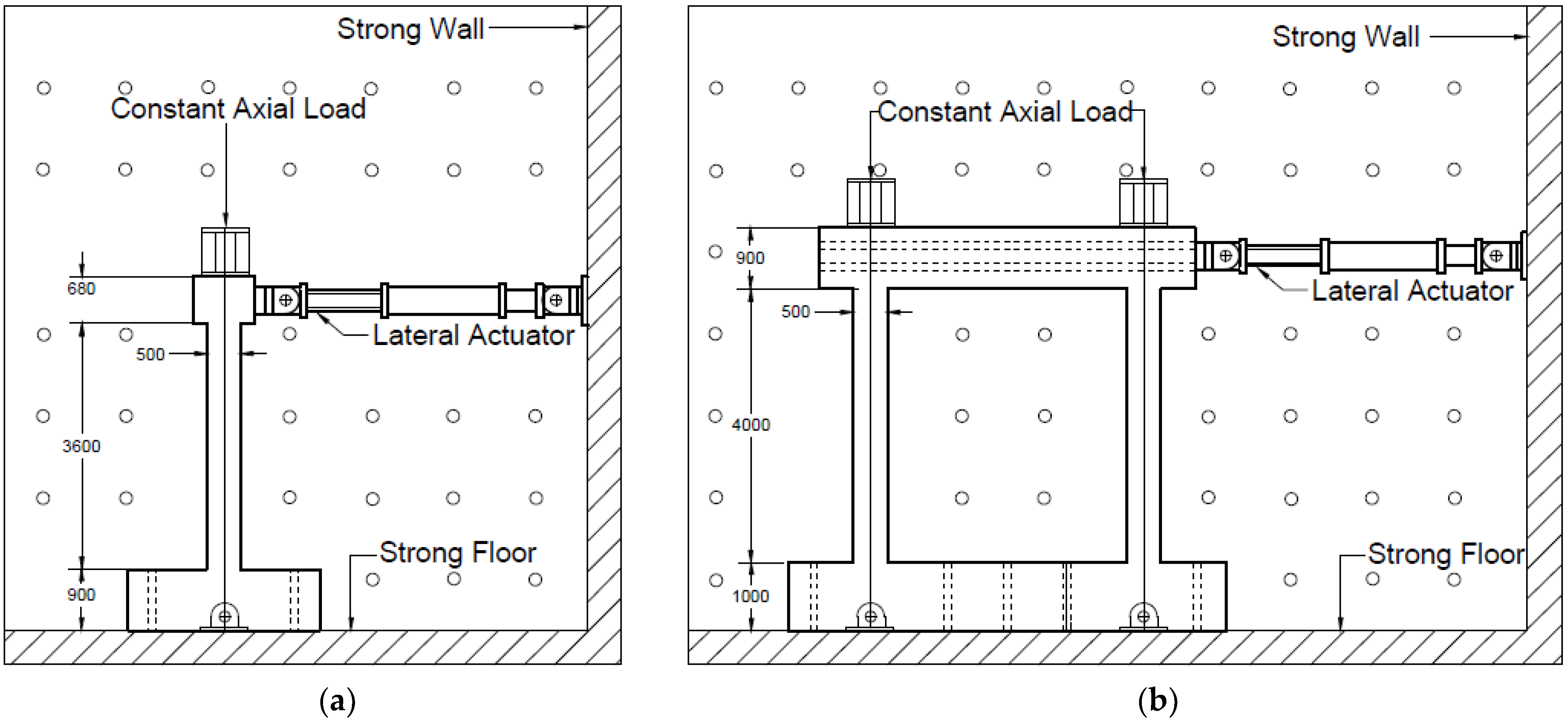
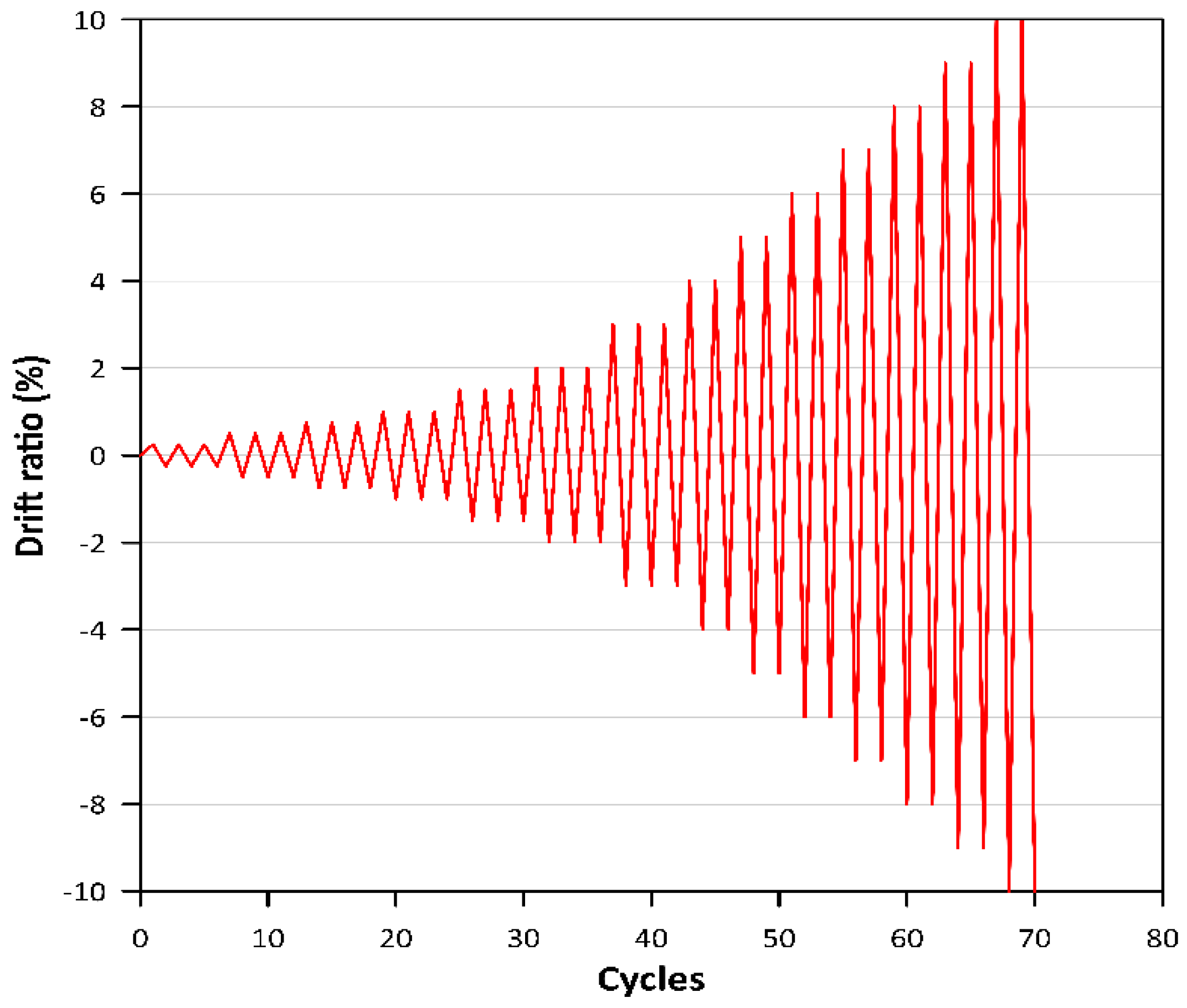
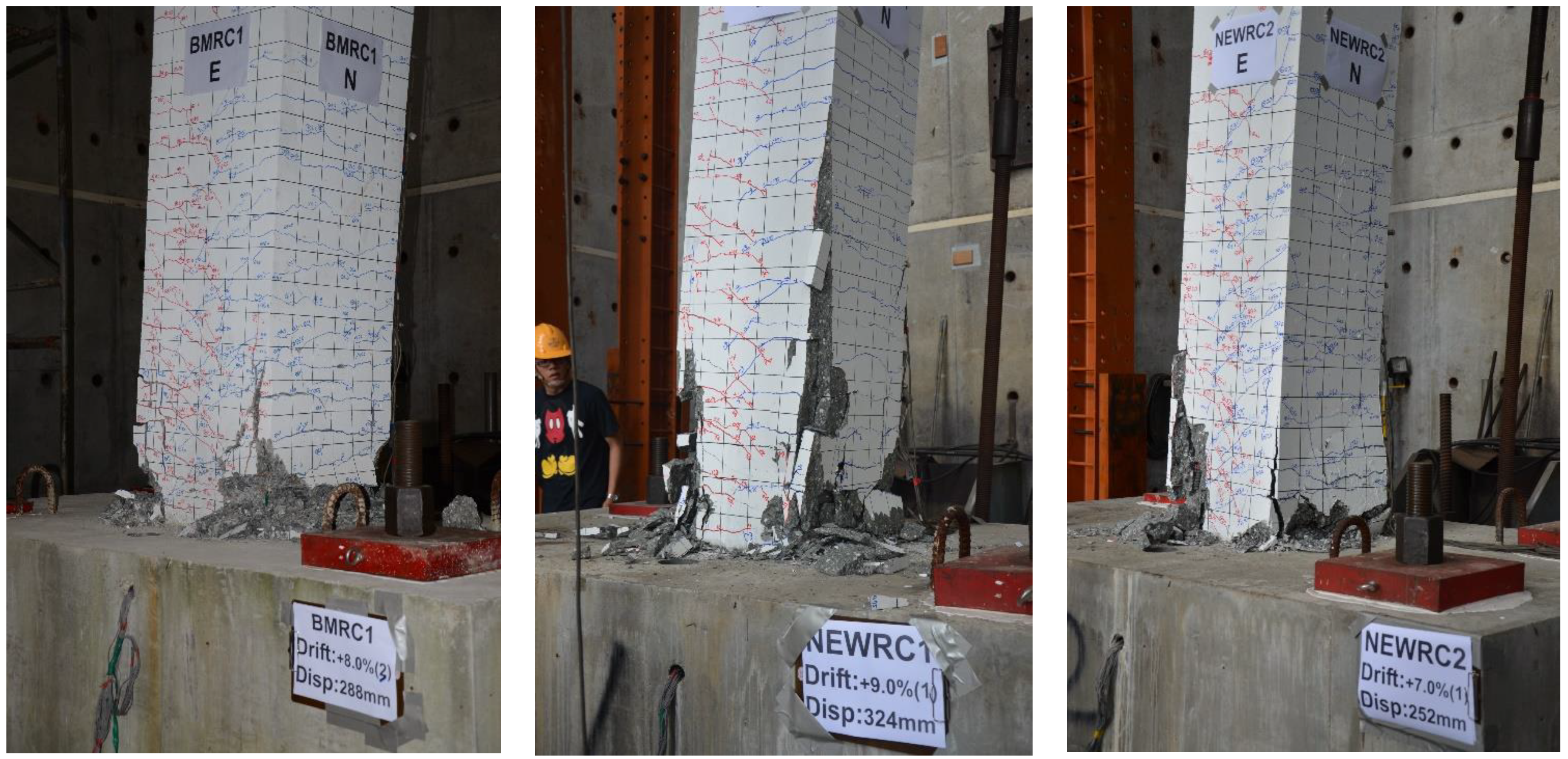


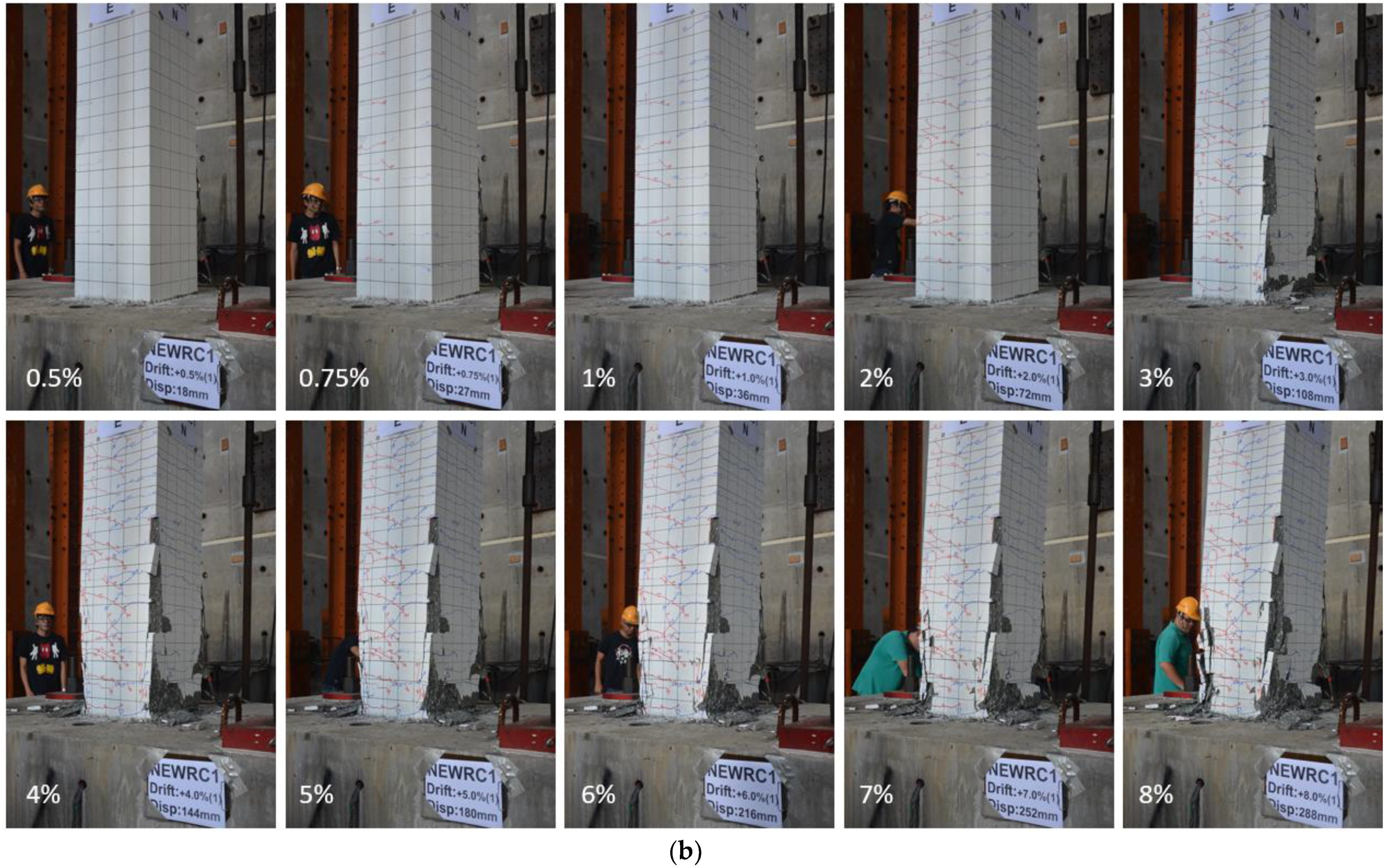
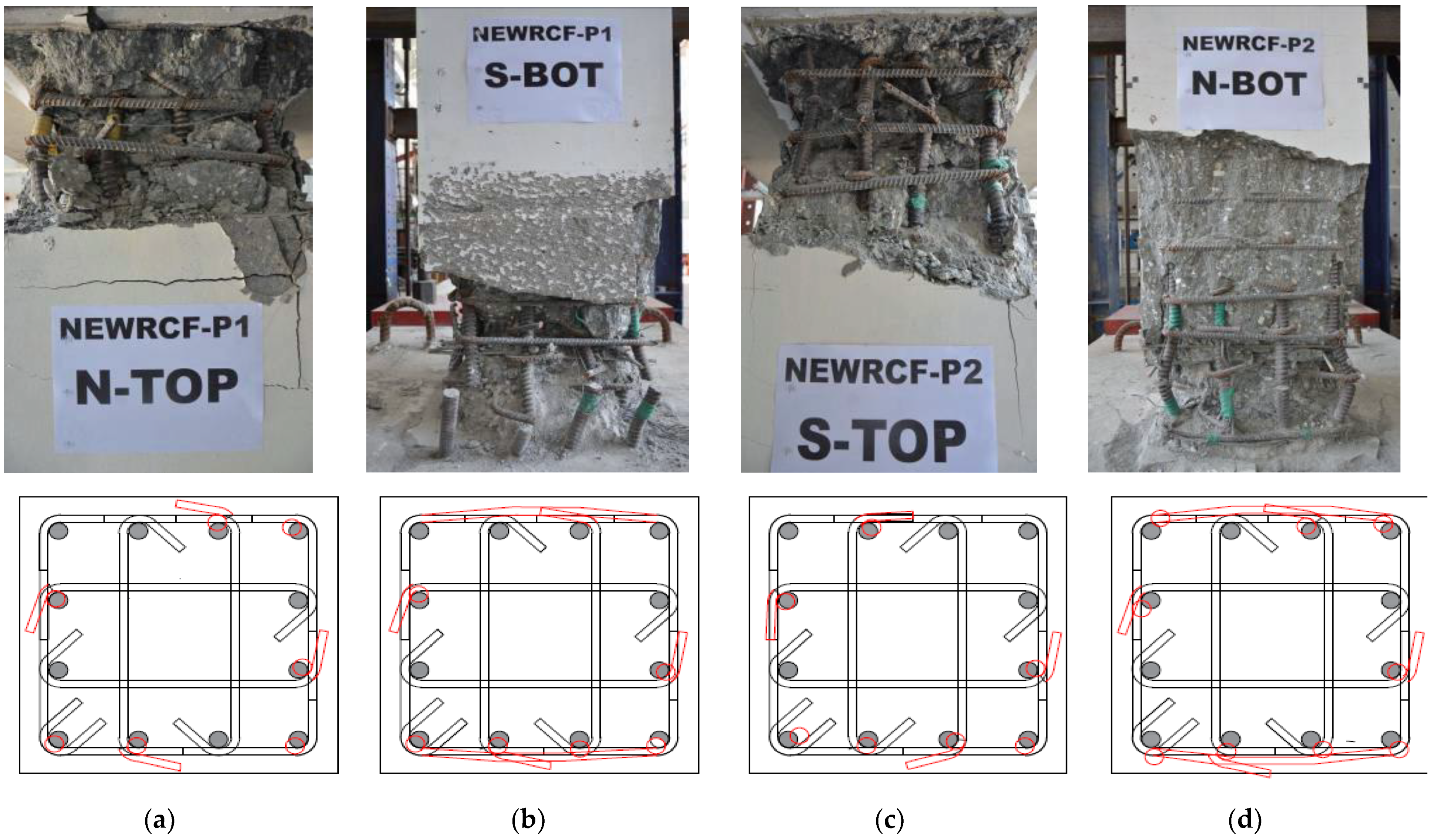
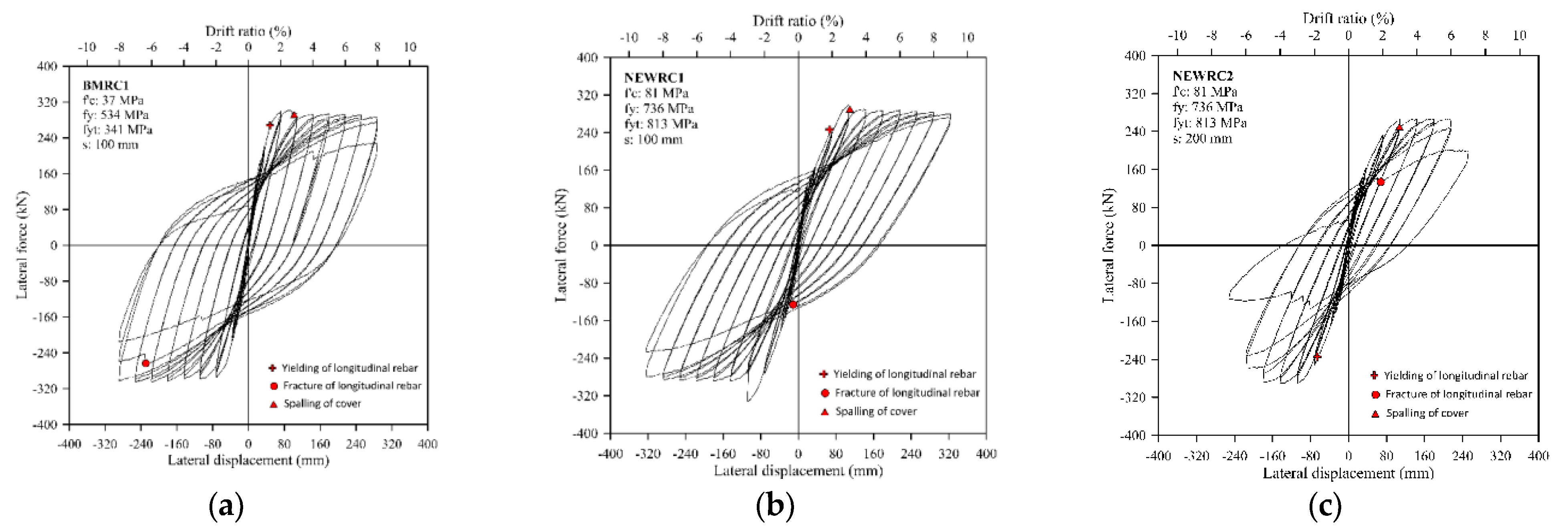

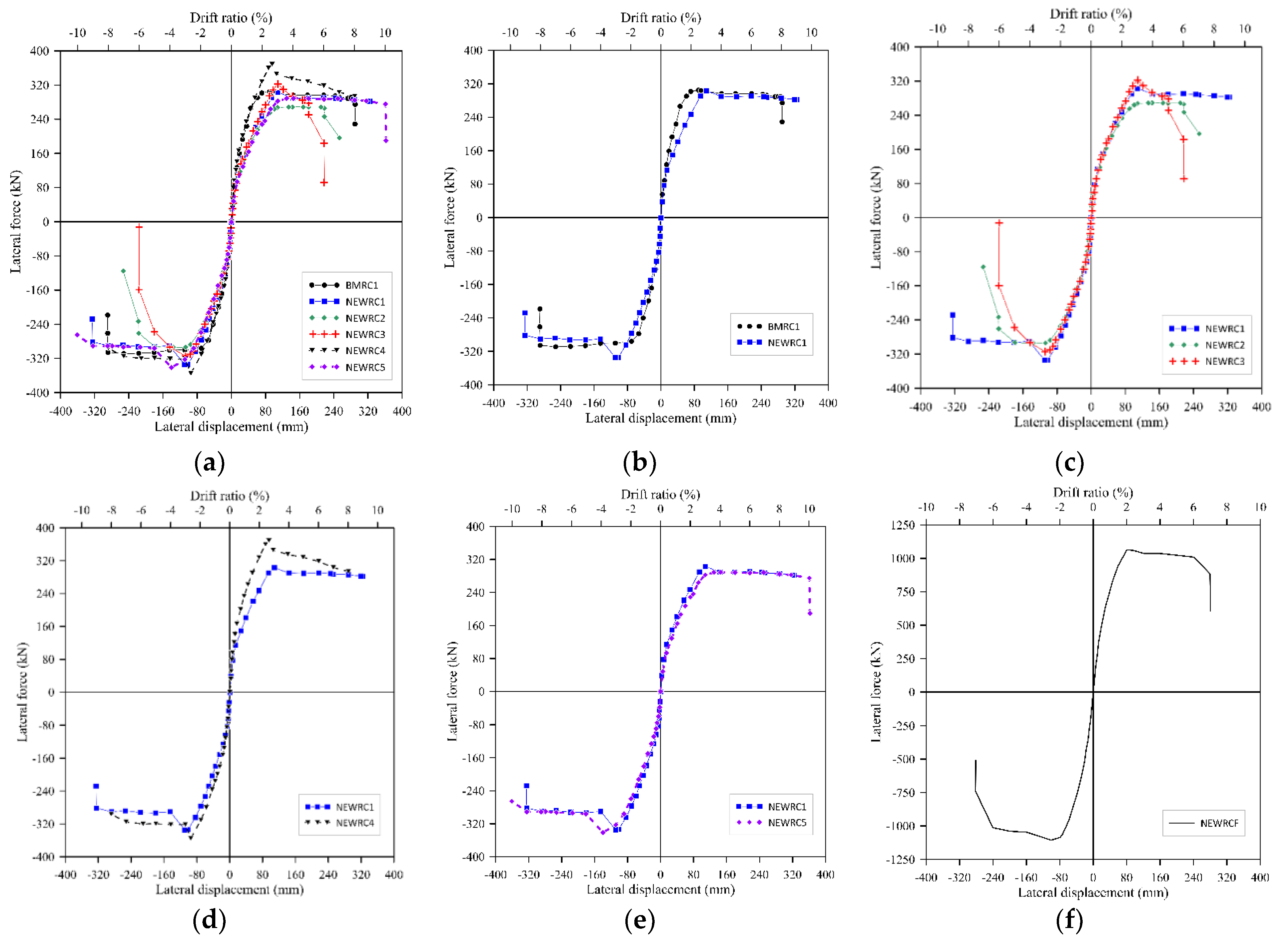
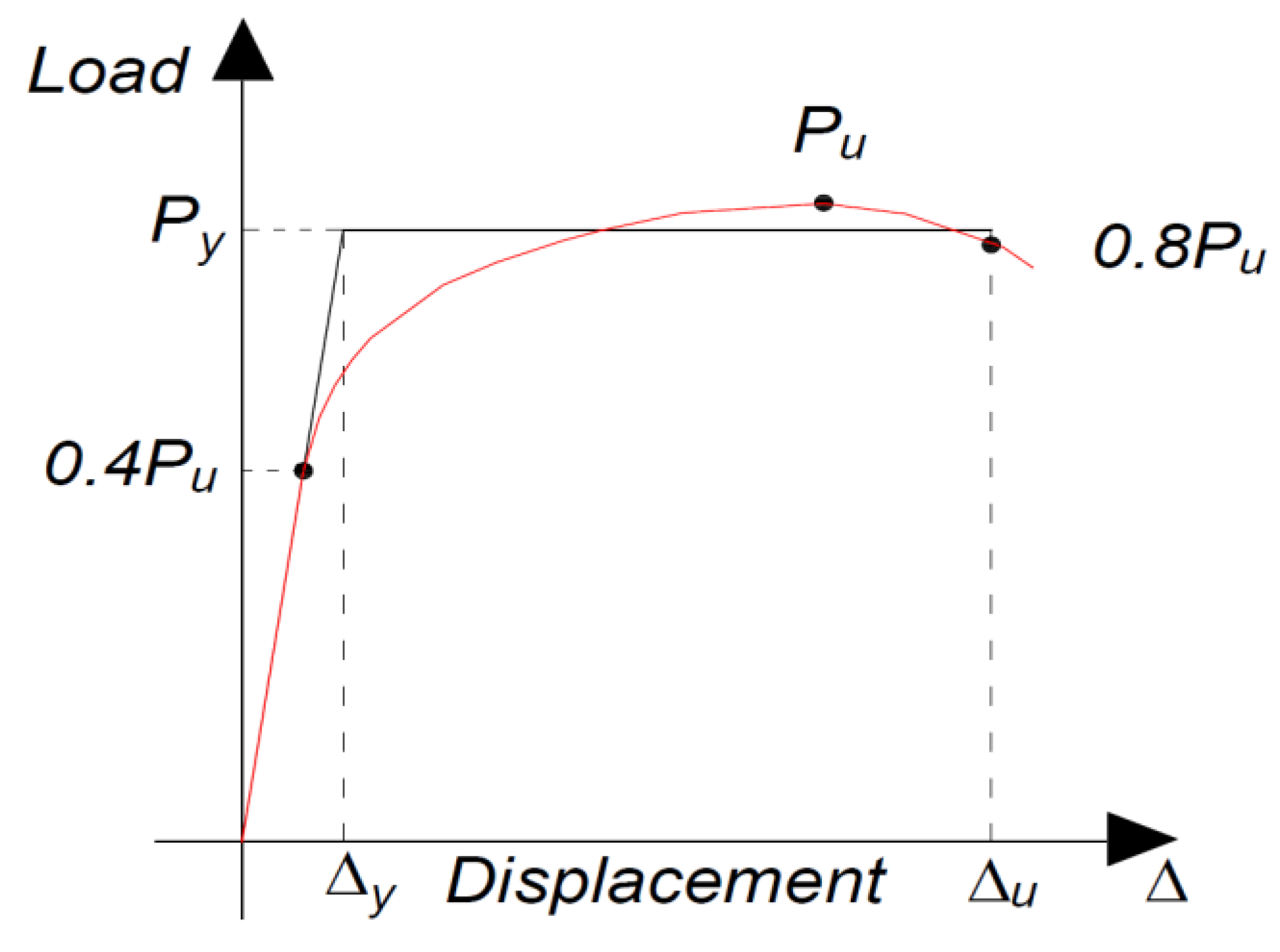

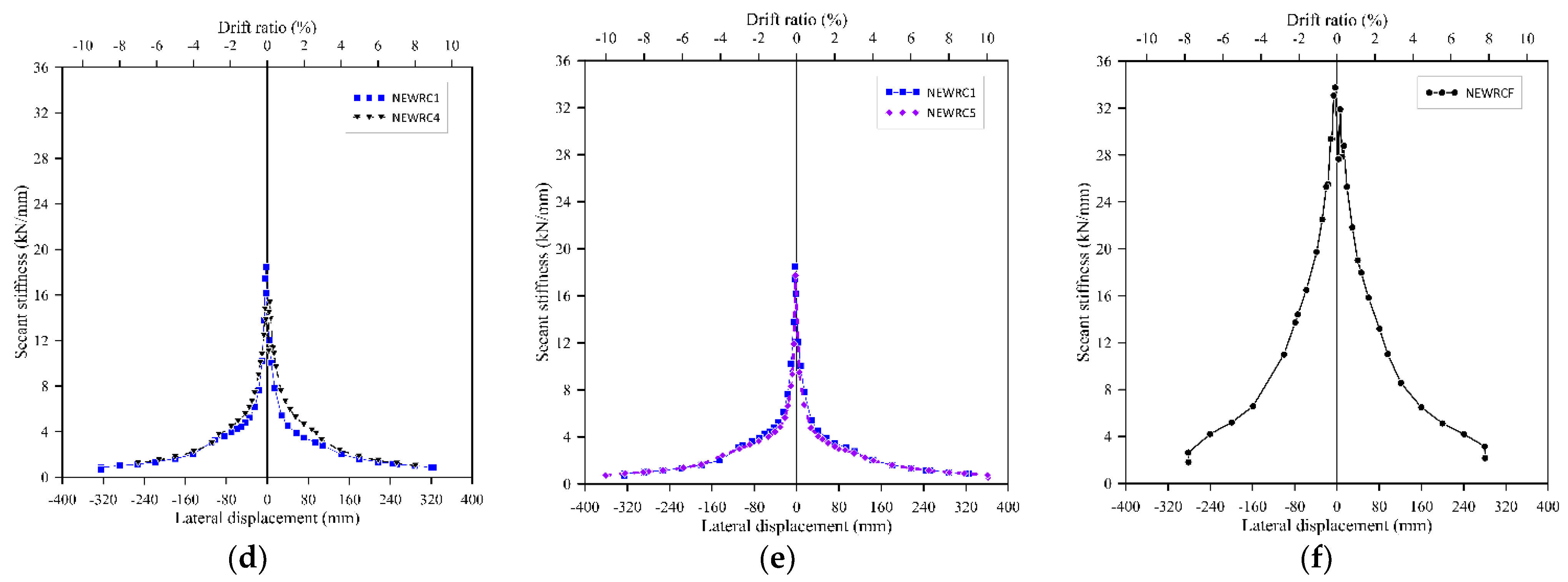
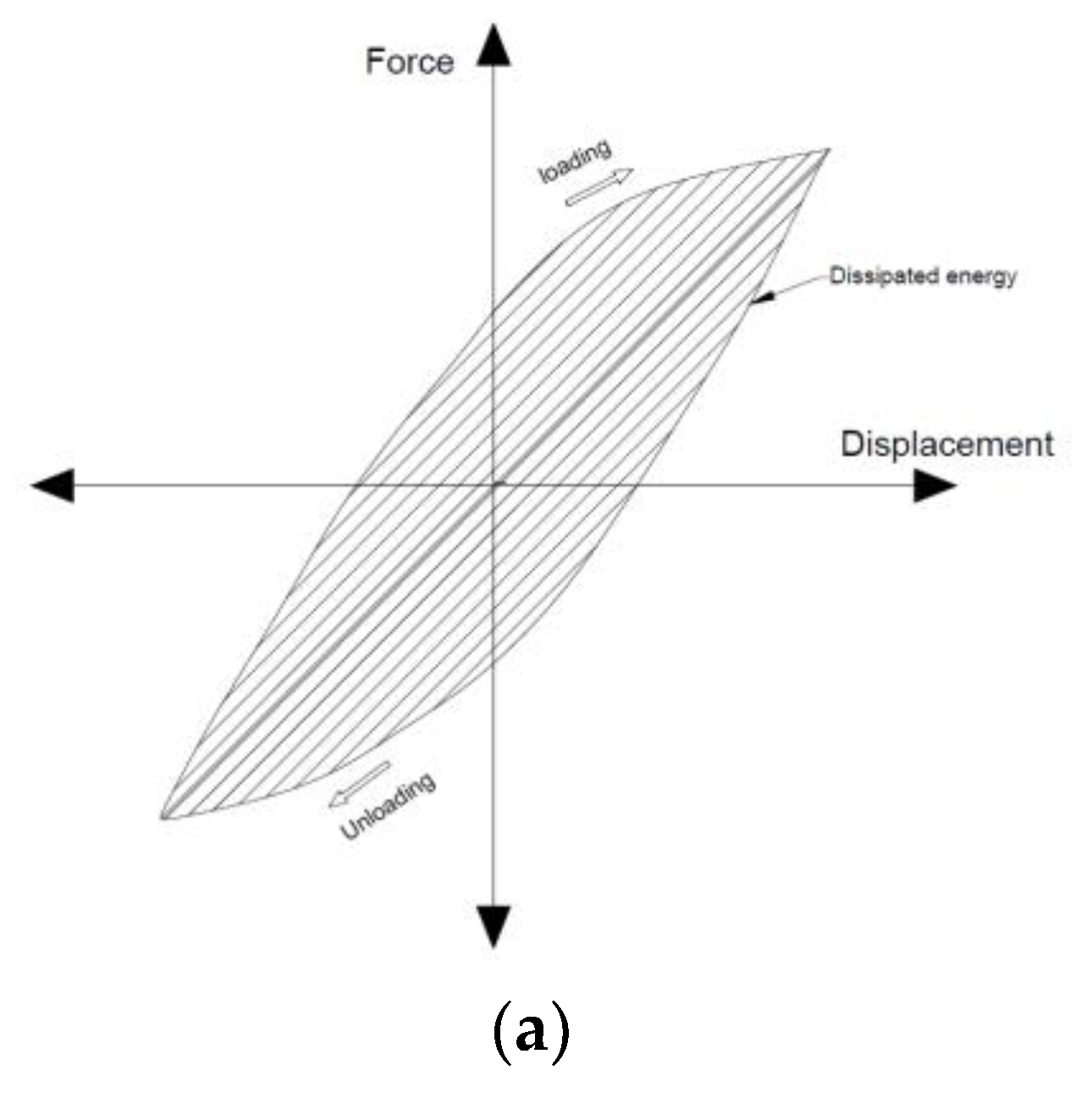
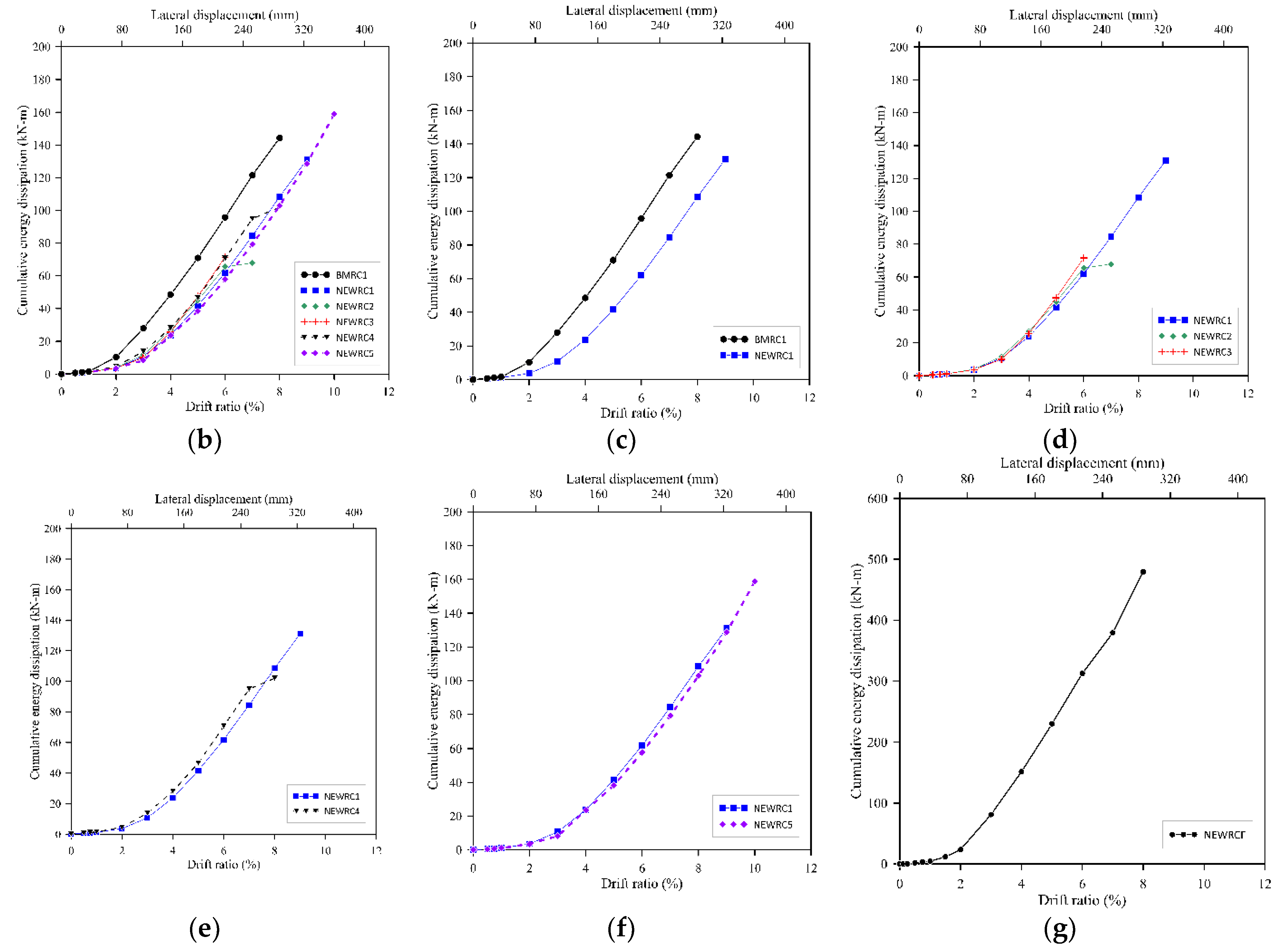
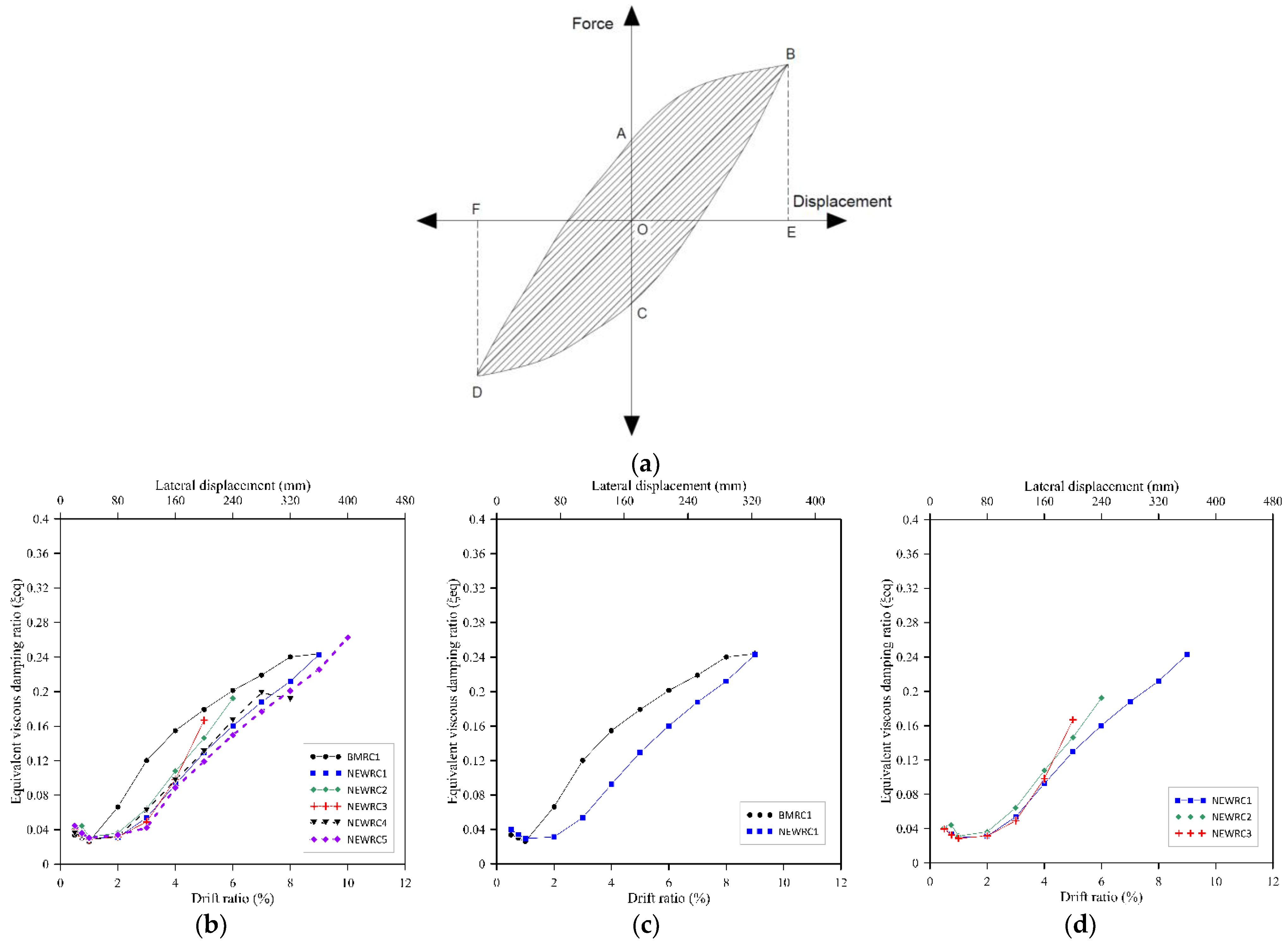
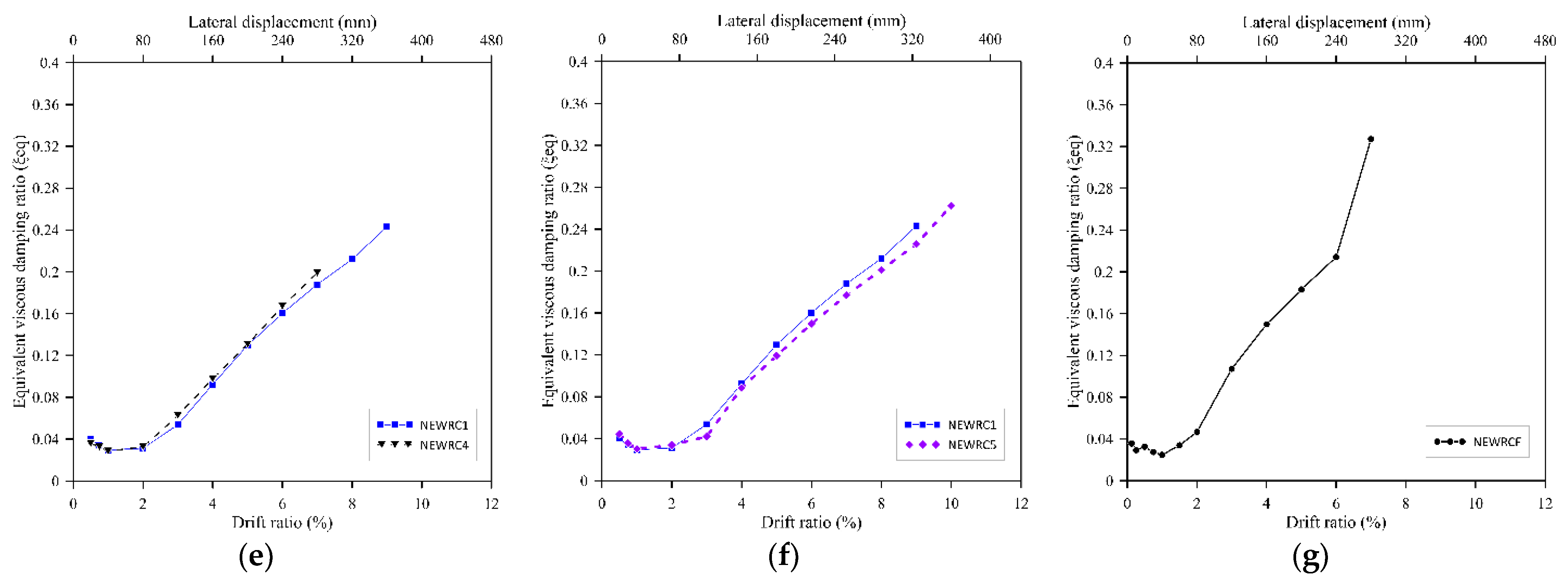
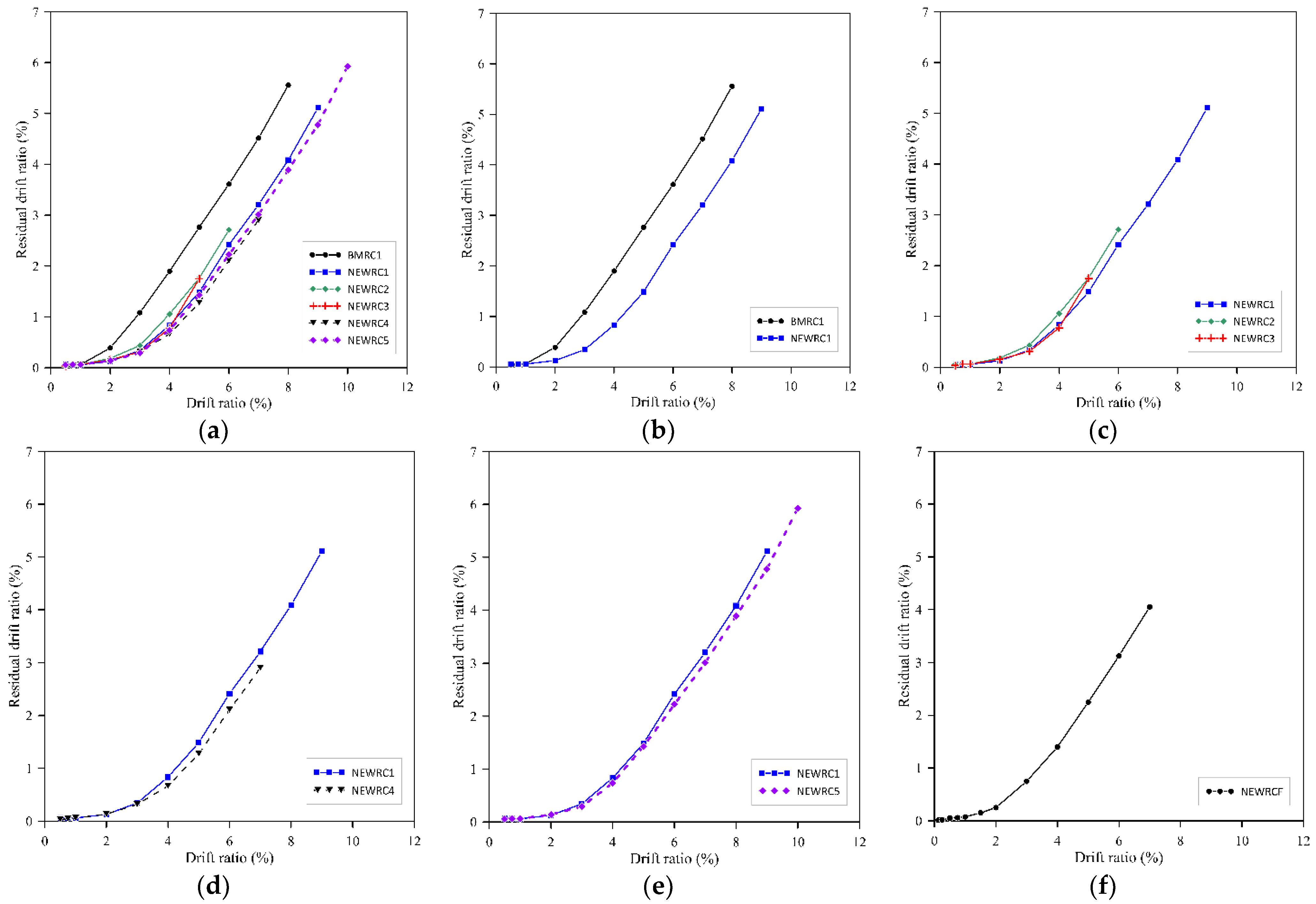

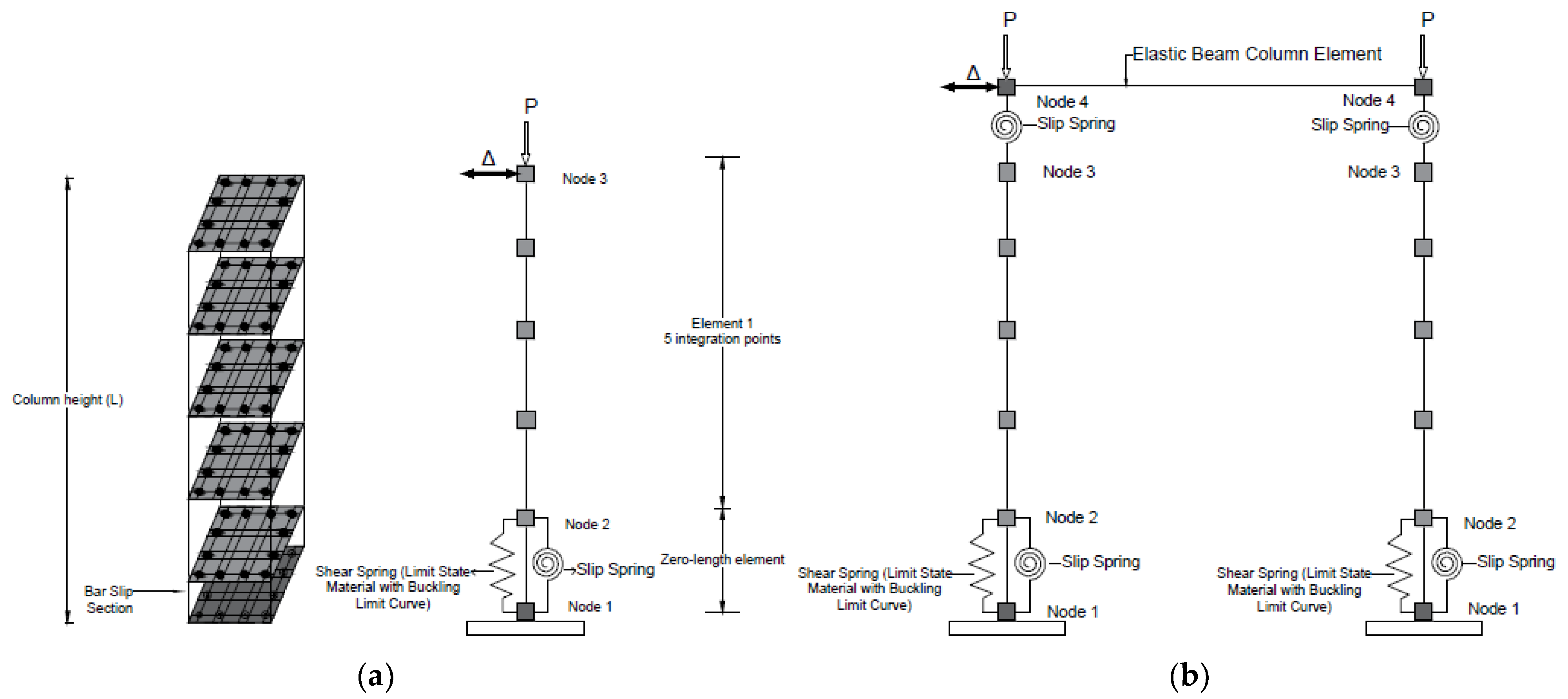

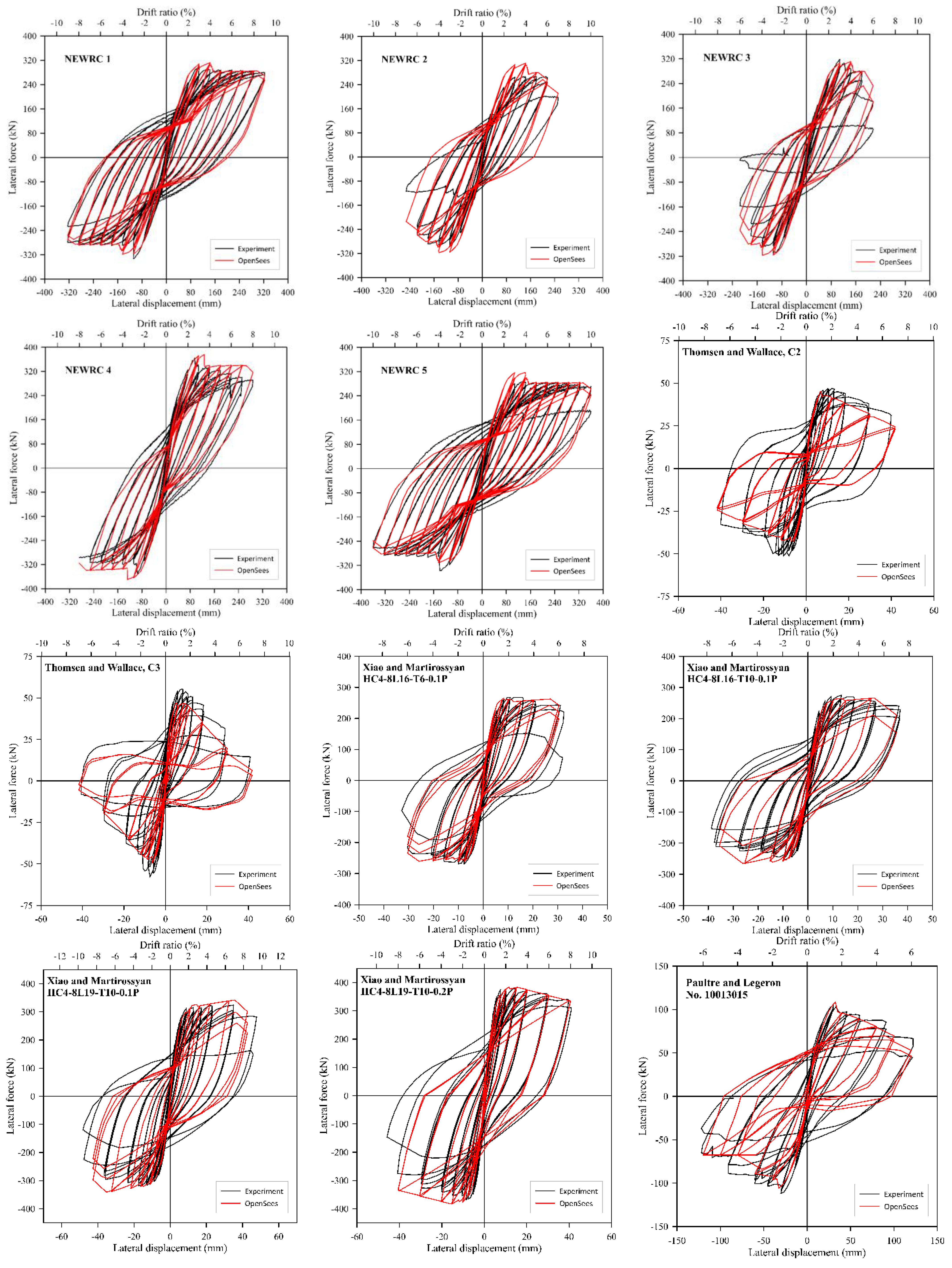

| Cement | Fly Ash | Silica Fume | Coarse Aggregate | Fine Aggregate | Water | S.P. |
|---|---|---|---|---|---|---|
| 400 | 170 | 50 | 844 | 719 | 170 | 14.26 |
| Specimen | Concrete Compressive Strength | Longitudinal Reinforcement, D25 (#8) | Transverse Reinforcement, D13 (#4) | Axial Compression Ratio | |||
|---|---|---|---|---|---|---|---|
| (MPa) | (MPa) | (%) | (MPa) | (%) | (%) | ||
| BMRC1 | 37 | 534 | 2.26 | 341 | 1.08 | 100 | 0.066 |
| NEWRC1 | 80.9 | 736 | 2.44 | 813 | 1.03 | 100 | 0.066 |
| NEWRC2 | 80.9 | 736 | 2.44 | 813 | 0.516 | 200 | 0.066 |
| NEWRC3 | 80.9 | 736 | 2.44 | 813 | 0.344 | 300 | 0.066 |
| NEWRC4 | 80.9 | 736 | 2.44 | 813 | 1.03 | 100 | 0.132 |
| NEWRC5 | 80.9 | 736 | 2.44 | 341 | 1.03 | 100 | 0.066 |
| NEWRCF | 80 | 723 | 2.3 | 833 | 1.29 | 100 | 0.1 |
| Specimen | Yield Point | Peak Point | Ultimate Point | Rebar Buckling | ||||||
|---|---|---|---|---|---|---|---|---|---|---|
| Py | θy | Pp | θp | Pu | θu | μ = ϑu/ϑy | ∆bbexp | ∆bbpred | ∆bbexp/∆bbpred | |
| Kn | (%) | Kn | (%) | Kn | (%) | (%) | (%) | |||
| BMRC1 | 264 | 1.94 | 306 | 2.50 | 259 | 8.00 | 5.76 | 7.50 | 6.55 | 1.15 |
| NEWRC1 | 287 | 1.64 | 333 | 3.00 | 282 | 9.00 | 5.49 | 8.00 | 7.32 | 1.09 |
| NEWRC2 | 267 | 1.63 | 292 | 5.00 | 246 | 6.00 | 3.66 | 6.00 | 6.27 | 0.96 |
| NEWRC3 | 286 | 1.71 | 323 | 3.00 | 278 | 5.00 | 2.95 | 5.00 | 5.92 | 0.84 |
| NEWRC4 | 314 | 1.37 | 364 | 2.70 | 293 | 8.00 | 5.88 | 6.94 | 6.80 | 1.02 |
| NEWRC5 | 280 | 1.73 | 338 | 3.90 | 275 | 10.00 | 5.81 | 9.00 | 6.03 | 1.49 |
| NEWRCF | 1028 | 1.35 | 1087 | 2.50 | 884 | 7.00 | 5.19 | 6.64 | 5.96 | 1.11 |
| References | Column | (MPa) | (MPa) | (MPa) | (mm) | (mm) | (%) | (%) | Test Type | ||
|---|---|---|---|---|---|---|---|---|---|---|---|
| This research | NEWRC1 | 80.9 | 736 | 813 | 500 | 500 | 7.2 | 0.066 | 2.44 | 1.03 | C |
| NEWRC2 | 80.9 | 736 | 813 | 500 | 500 | 7.2 | 0.066 | 2.44 | 0.52 | C | |
| NEWRC3 | 80.9 | 736 | 813 | 500 | 500 | 7.2 | 0.066 | 2.44 | 0.34 | C | |
| NEWRC4 | 80.9 | 736 | 813 | 500 | 500 | 7.2 | 0.132 | 2.44 | 1.03 | C | |
| NEWRC5 | 80.9 | 736 | 341 | 500 | 500 | 7.2 | 0.066 | 2.44 | 1.03 | C | |
| Paultre and Legeron, 2000 [47] | No. 10013015 | 94.8 | 729 | 637 | 305 | 305 | 6.5 | 0.136 | 2.15 | 0.76 | C |
| Thomsen and Wallace 1994 [48] | C2 | 74.6 | 738 | 1448 | 152.4 | 152 | 3.9 | 0.1 | 2.45 | 0.62 | C |
| C3 | 81.8 | 738 | 1448 | 152.4 | 152 | 3.9 | 0.2 | 2.45 | 0.62 | C | |
| Xiao and Martirossyan 1998 [46] | HC4-8L19-T10-0.1P | 76 | 510 | 510 | 254 | 254 | 2 | 0.1 | 2.46 | 1.5 | DC |
| HC4-8L19-T10-0.2P | 76 | 510 | 510 | 254 | 254 | 2 | 0.2 | 3.5 | 1.5 | DC | |
| HC4-8L16-T10-0.1P | 86 | 510 | 510 | 254 | 254 | 2 | 0.096 | 2.46 | 1.5 | DC | |
| HC4-8L16-T6-0.1P | 86 | 510 | 510 | 254 | 254 | 2 | 0.096 | 2.46 | 0.75 | DC | |
| This research | NEWRCF | 80 | 723 | 833 | 500 | 500 | 8 | 0.1 | 2.3 | 1.29 | DC |
Publisher’s Note: MDPI stays neutral with regard to jurisdictional claims in published maps and institutional affiliations. |
© 2022 by the authors. Licensee MDPI, Basel, Switzerland. This article is an open access article distributed under the terms and conditions of the Creative Commons Attribution (CC BY) license (https://creativecommons.org/licenses/by/4.0/).
Share and Cite
Sharma, R.; Liu, K.-Y.; Witarto, W. Experimental and Numerical Investigation of the Seismic Performance of Bridge Columns with High-Strength Reinforcement and Concrete. Appl. Sci. 2022, 12, 5326. https://doi.org/10.3390/app12115326
Sharma R, Liu K-Y, Witarto W. Experimental and Numerical Investigation of the Seismic Performance of Bridge Columns with High-Strength Reinforcement and Concrete. Applied Sciences. 2022; 12(11):5326. https://doi.org/10.3390/app12115326
Chicago/Turabian StyleSharma, Raju, Kuang-Yen Liu, and Witarto Witarto. 2022. "Experimental and Numerical Investigation of the Seismic Performance of Bridge Columns with High-Strength Reinforcement and Concrete" Applied Sciences 12, no. 11: 5326. https://doi.org/10.3390/app12115326
APA StyleSharma, R., Liu, K.-Y., & Witarto, W. (2022). Experimental and Numerical Investigation of the Seismic Performance of Bridge Columns with High-Strength Reinforcement and Concrete. Applied Sciences, 12(11), 5326. https://doi.org/10.3390/app12115326





